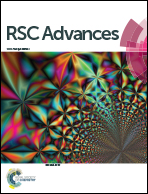Effect of Fe(iii) on the performance of sediment microbial fuel cells in treating waste-activated sludge
Abstract
Chemical energy stored in organic waste can be directly converted into electricity using sediment microbial fuel cell (SMFC) technology. The present study showed that adding Fe(III) enhanced the generation of electricity and degradation of waste-activated sludge (WAS) by increasing the content of c-type cytochromes (Cyt c) within the anode biofilm of SMFC reactors. With addition of 500 mg L−1 Fe(III), the cell voltage increased to 501.0 mV from 187.1 mV and VSS removal of WAS increased to 37.21% from 31.47% in the control. The content of crude Cyt c per mg biomass increased to 13.05 μg mg−1 in the SMFC-500 anode biofilm from 3.86 μg mg−1 in the control. However, the electron-transfer efficiencies of Cyt c were 2.25 mol-electron per μg in the SMFC-500 reactor and 3.64 mol-electron per μg in the control, showing that the addition of Fe(III) slightly inhibited the activity of Cyt c. Purified Cyt c possessed a molecular mass of 24 310 Da with 4.7 mol heme groups, and its secondary structure had 21% α-helix, 13.5% β-sheet, and was 31.3% unordered. Proteobacteria and iron-reducing bacteria within the SMFC anode biofilm were enriched by 500 mg L−1 Fe(III), but this same amount inhibited archaea colonization and decreased the diversity of the microbial community without an obvious difference in the dominant phylum.


 Please wait while we load your content...
Please wait while we load your content...